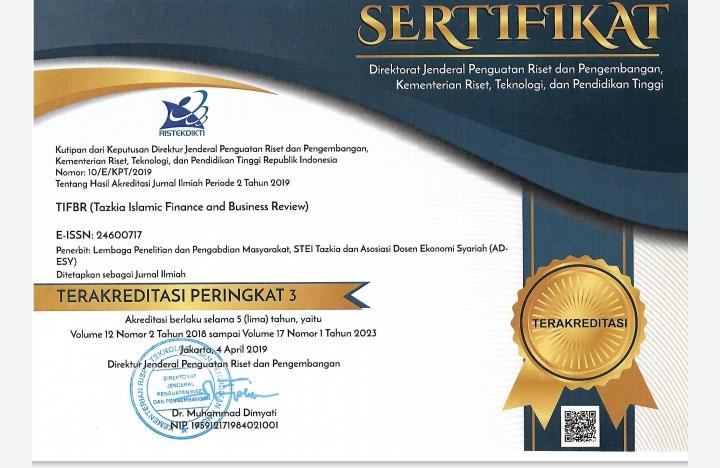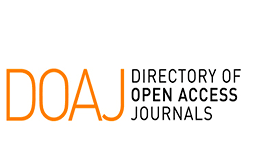The Comparison of Sukuk and Bond Absorption; Deficit Budget Financing in Indonesia
DOI:
https://doi.org/10.30993/tifbr.v10i2.106Keywords:
Sukuk, Bond and Deficit BudgetAbstract
Objectives: This study aims to analyze: (i) the comparison of sukuk and bond absorption in deficit budget financing; and (ii) which variable that has significant effect on deficit budget (Y1= equation 1), on bond (Y2= equation 2) and on sukuk (Y3 = equation 3).
Method: This study uses Two Stage Least Square (2SLS) method. The data used is from Bank of Indonesia, BPS, Ministry of Finance, IDX, ministry of trade, with monthly data, February 2009 – December 2015.
Results: The result shows that sukuk has a significant negative effect on deficit budget while bond has a significant positive effect on deficit budget. In addition, import has a significant negative effect on deficit budget while exchange rate variable has a significant positive effect on deficit budget (the first equation). BI rate has significant negative effect on bond, while SBI and deficit budget has significant positive effect on bond (the second equation). Then, Inflation and bond has significant positive effect on sukuk, while deficit budget has significant negative effect on sukuk (the third equation).
Conclusion: Both sukuk and bond have significant correlation in increasing each of them. Furthermore, both sukuk and bond have significant effect on deficit budget.References
Al-Amine, Muhammad Al Bashir M. (2008). “Sukuk Market: Innovation and Challenges”. Islamic Economic Studies, Vol. 15(2).
Chapra, M. Umer. Islam. (1992). The Economic Challenge. International Islamic Publishing House, Riyadh, Saudi Arabia. Page 119-126.
Diyanti. (2011). “Islamic Economic Overview on Sukuk Fund Allocations in the Budget (APBN)”. Fakultas Syariah dan Hukum Unversitas Islam Negeri Syarif Hidayatullah Jakarta. [Bachelor Thesis]
Fatah, Dede Abdul. (2011). “Perkembangan Obligasi Syariah (Sukuk) di Indonesia: Analisis Peluang dan Tantangan”. AL-‘ADALAH Jurnal Hukum Islam, Vol 10 (1).
Gujarati, Damodar N. (2003). Basic Econometrics fourth edition. McGraw-Hill, New York.
Harahap, Fadlyka Himmah S. (2009). “Kebijakan Penerbitan Sukuk sebagai Instrumen Pembiayaan Defisit APBN”. Fakultas Syariah dan Hukum Unversitas Islam Negeri Syarif Hidayatullah. [Bachelor Thesis]
Hariyanto, Eri. (2014). the Comparison of Sukuk and Bond Issuance. Public Finance Subject. STEI Tazkia.
Hariyanto, Eri. (2015). Strategi Pengembangan Pasar Sukuk Negara. Direktorat Jendral Pengelolaan Utang Kementerian Keuangan Republik Indonesia. Jakarta.
Indra. (2014). Modul Mata Kuliah Ekonometrik 2 Mengenai Model Persamaan Simultan. STEI Tazkia.
Khan, Nora. (2016). “The Role of Islamic Finance in Economic Development”. Lingnan Journal of Banking, Finance and Economics, Vol 6 (1).
Koutsoyiannis, A. (1977). Theory of Econometrics, 2nd edition. MacMillan Publisher Ltd, Hongkong.
Nasrullah, Aan. (2015). “Studi Surat Berharga Negara: Analisis Komparatif Sukuk Negara dengan Obligasi Negara Dalam Pembiayaan Defisit APBN”. Jurnal LENTERA Kajian Keagamaan, Keilmuan dan Teknologi. ISSN: 1693 – 6922.
Rahardja, Prathama dan Manurung, Mandala. (2005). Teori Ekonomi Makro Suatu Pengantar. Edisi Ketiga. Jakarta: Lembaga Penerbit Fakultas Ekonomi Universitas Indonesia. Hal 16-21 dan 137-152.
Raharjo, Sapto. (2004). Panduan Investasi Obligasi. PT Gramedia Pustaka Utama.
Rini, Mustika. (2012). “Obligasi Syariah (Sukuk) dan Indikator Makroekonomi Indonesia: Sebuah Analisis Vector Error Correction Model (VECM)”. Fakultas Ekonomi dan Manajemen: Institut Pertanian Bogor.
Salim, Fahmi. (2011). “Konsep dan Aplikasi Sukuk Negara Dalam Kebijakan Fiskal di Indonesia”. UIN Syarif Hidayatullah. [Bachelor Thesis]
Sunariyah. (2006). Pengantar Pengetahuan Pasar Modal. Yogyakarta: Sekolah Tinggi Ilmu Manajemen.
Surya, Budhi Arta dan Nasher, Teguh Gunawan. (2011). “Analisis Pengaruh Tingkat Suku Bunga SBI, Exchange Rate, Ukuran Perusahaan, Debt to Equity Ratio dan Bond Terhadap Yield Obligasi Korporasi di Indonesia”. Jurnal Manajemen Teknologi Vol. 10 (2).
Downloads
Published
How to Cite
Issue
Section
License

Tazkia Islamic Finance and Business Review (TIFBR) is licensed under a Creative Commons Attribution-NonCommercial 4.0 International License.
Authors who publish with this journal agree to the following terms:
- Authors retain copyright and grant the journal right of first publication with the work simultaneously licensed under a Creative Commons Attribution License that allows others to share the work with an acknowledgment of the work's authorship and initial publication in this journal.
- Authors are able to enter into separate, additional contractual arrangements for the non-exclusive distribution of the journal's published version of the work (e.g., post it to an institutional repository or publish it in a book), with an acknowledgment of its initial publication in this journal.
- Authors are permitted and encouraged to post their work online (e.g., in institutional repositories or on their website), as it can lead to productive exchanges, as well as earlier and greater citation of published work (See the Effect of Open Access).

















